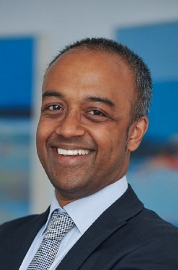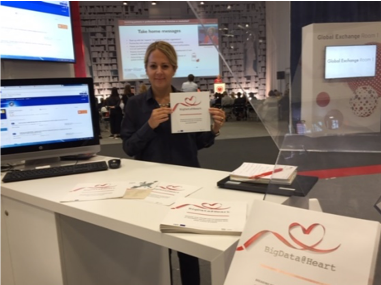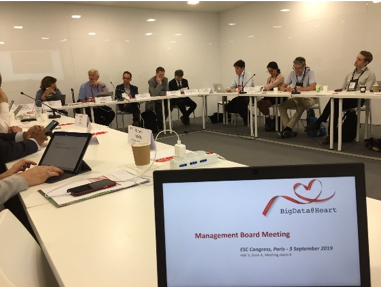BigData@Heart at ESC Congress 2019 in Paris
The BigData@Heart consortium organised a symposium, public presentations and internal project meetings at the ESC  Congress 2019 which took place from 31 August to 4 September 2019 in Paris Expo Porte de Versailles.
Congress 2019 which took place from 31 August to 4 September 2019 in Paris Expo Porte de Versailles.
The ESC Congress is the world’s largest and most influential scientific congress for cardiovascular professionals, attracting more than 30,000 specialists, showcasing more than 500 sessions and over 4,500 abstract presentations with a world-renowned faculty.
This year the ESC Congress was held together with the World Congress of Cardiology. The spotlight of the event was Global Cardiovascular
Health.
How Big Data will impact cardiology: a physician’s guide’ Symposium
 On 1 September the BigData@Heart symposium How Big Data will impact cardiology: a physician’s guide (Chairpersons: Folkert Asselbergs, Maureen Cronin) highlighted how big data will affect clinical practice in cardiology and how to unlock the potential of big data for the benefit of the patients.
On 1 September the BigData@Heart symposium How Big Data will impact cardiology: a physician’s guide (Chairpersons: Folkert Asselbergs, Maureen Cronin) highlighted how big data will affect clinical practice in cardiology and how to unlock the potential of big data for the benefit of the patients.
Starting from an introduction to the vast availability of big data in cardiology, Folkert Asselbergs outlined the importance of phenotyping, data standards for external validation, national and international collaboration to face forthcoming challenges.

Spiros Denaxas discussed the three different types of machine learning - supervised, unsupervised, reinforcement learning - to enable precision medicine approaches. He specifically referred to the importance of interpretability, prospective validation, clinical effectiveness, and being able to communicate to patientsand the public clearly and in a simple way how decisions are taken.
Aroon Hingorani drew audience’s attention to omics and big data and how they impact the definition of disease. The floor was given to Lars Lund who explained how big data can help to understand the complexity of heart failure, to use existing therapies for heart failure patients with reduced ejection fraction and to develop new therapies for heart failure patients with preserved ejection fraction.
Daniel Freitag concluded bringing in industry’s aspiration for a “one-stop shop”, one ecosystem which caters different questions related to drug development and beyond.
BigData@Heart Presentations

On 3 September Harry Hemingway’s speech brought new insights into health records and heart failure as an exemplar. He highlighted the need to convert raw electronic health record data into something that is research ready and clinic ready with replicable useful definitions, combining “code sets” with algorithms and validations. Furthermore, two interesting late breaking trial presentations by Benedikt Schrage and Gianluigi Savarese summarised the latest analyses performed under the BigData@Heart project and published in the journals Circulation-Heart Failureand European Journal of Heart Failurerespectively:
- Association between use of primary prevention implantable cardioverter-defibrillators and mortality in patients with heart failure. A prospective propensity-score matched analysis from the Swedish heart failure registry.
- Association between beta-blocker use and mortality/morbidity in older patients with heart failure with reduced ejection fraction. A propensity score-matched analysis from the Swedish Heart Failure Registry.
Special attention was given to promote the BigData@Heart sessions via the project website and the twitter account. The congress attendees had the chance to visit the ESC stand, to get in touch with the project representatives, receive info and materials, and discuss possible collaborations.
BigData@Heart closed meetings

During the ESC Congress, meetings of the BigData@Heart Management Board and participants from Case Study 1 were organised to review the latest achievement and to plan the forthcoming activities.
Case study 1 participants discussed the future of clinical trials, comparing patient characteristics, eligibility for enrolment, concomitant medication use and health outcomes from HF registries and in trial participants.
The BigData@Heart Management Board meeting gathered together 20 scientists to report on the progress of their work, to highlight main challenges, and to share ideas on how to tackle them. Project partners explored possibilities for exploiting project results. Furthermore, several actions were proposed to engage regulatory agencies and healthcare policy makers. Also, upcoming papers, congress sessions and webinars were scheduled.